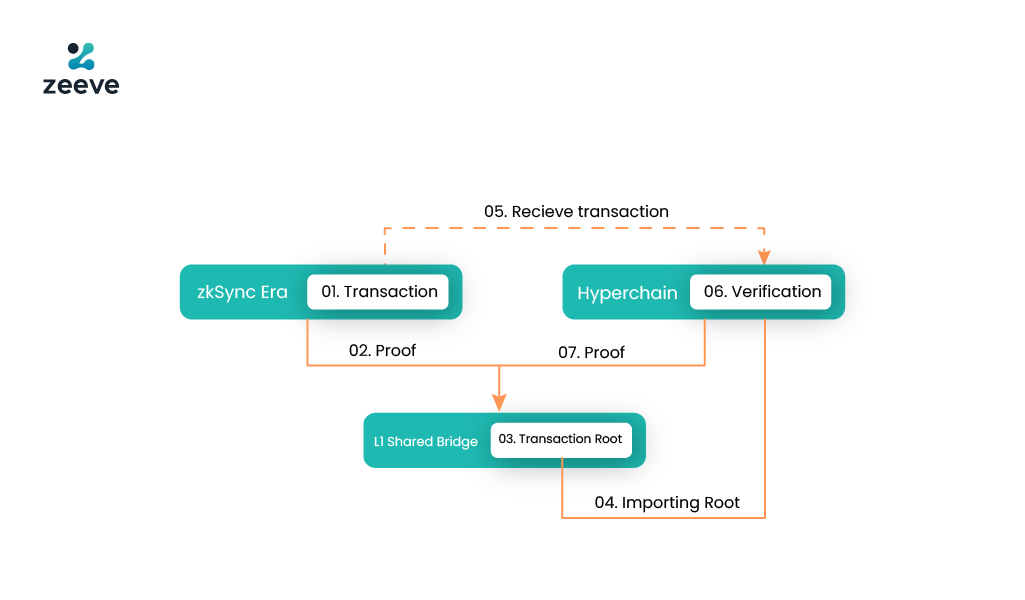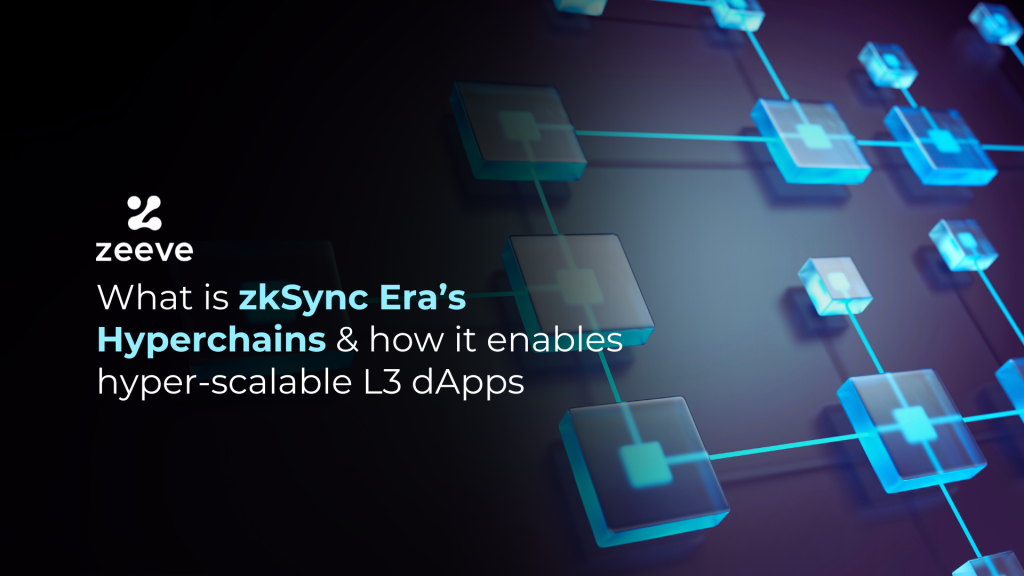Vitalik Buterin’s claim for zkRollups to be the scaling solution’s end game has already paved the way for the success of various Zk-powered layer-2 scaling solutions. As an advanced, future-facing Layer-2 scaling solution– the zkSync Era marks its participation by introducing ZkStack and hyper-scalable chains built using zkStack. This comprehensive guide explains the broader concept of zkSync Era’s Hyperchains, diving deeper into hyperchain, its stack, features, use cases, and the approach of enabling hyper-scalable L3 dApps.
Understanding Hyperchains and its development framework— ZkStack
Hyperchains, offered by zkSync are hyper-scalable, interoperable, custom, and fully sovereign zk-chains running on the top of Layer-1 or Layer-2 networks while being connected, able to get security and finality from the main chain (L1).
You can say Hyperchains are a Zk version of OP Stacks’ Superchains. There’s a difference in rollup implementation as Superchains are based on Optimistic rollup technology, whereas hyperchains use zk-rollups.
The development stack for hyperchains is ZkStack. This is a highly optimized, open-source, and modular framework for building custom zk-chains layer-2 and layer-3. zkSync has designed its zkStack with significant improvements to address the challenges of its previous stack– ZK Credo.
zkStack offers unique benefits such as easy implementation of Account Abstraction in any zk-enabled architecture, 1000X cheaper transactions compared to general rollup chains, and optional extension with zkPorter accounts for highly affordable use cases.
All the hyperchains use 100% identical circuits, ensuring each of them can trust the activities happening on other chains with no need for assumptions. Anyone with extensive experience in zkStack can build modular, app-specific–yet highly secure zk-rollup chains and deploy them permissonlessly on the zkSync Era ecosystem.
The architecture of Hyperchains and its working
Hyperchains work as independent zkrollup chains that compute transactions separately from Layer-1, generate zk-proof, and submit it to L1. Instead of settling up their proofs individually, hyperchains can aggregate all the proofs and voluntarily agree to settle all the batches’ proofs in a single proof and then publish to Layer-1. Simple proof aggregation, L3 proof settling, and layered aggregation are the multiple options for hyperchains to choose from for proof aggregation.
All the hyperchains can seamlessly and trustlessly communicate with each other, forming an interoperable and rich ecosystem for zkSync. zkSync’s hyperchains, at its core, solve the challenge of sharing liquidity and asset movements between L2 rollups and Layer-1 blockchain. For example, think of hyperchains as an email interface where you can send email from any address on any domain to a completely different address of a different domain. All these happen in a fraction of a second and with complete trust because each chain has access to each other’s state, and they all share a common bridge smart contract running on the mainchain. Refer to the below image for a graphical explanation of hyperchains:

Who should build Hyperchains?
Hyperchains unlock a plethora of benefits, yet they are not meant for every web3 project. Let’s say you are building a regular NFT or DeFi dApp; deploying on a Layer-2 such as zkSync Era is a fair deal as you will get a production-ready ecosystem with all the default features, consensus, and chain-specific components.
But, if you need a fully customized Zk Chain that offers single-use infrastructure, custom tokenomics, unique fee mechanism, TPS adjustability, smart contract logics, VM, prover, DA layer sequencer—then you go for Hyperchains. Following are the potential applications that will be greatly benefited by building their project as hyperchains:
- Any Layer-1 blockchain that seeks scalability by launching their standalone zk-powered chains.
- Gaming applications that wants to customize their ecosystem to make it player-centric. For example– offering gasless transactions, setting TPS as high as possible to get massive throughput, or allowing players to explore a broader ecosystem of interconnected hyperchains.
- Crypto exchanges looking for low latency chains that also offer unfragmented liquidity.
- DeFi or Enterprise-grade solutions that want a private chain while maintaining communication with other chains.
- dApps that want a specific token to use of their base token.
- Enterprise building a range of applications and wanting them all to interoperate with each other via a native bridge.
How Hyperchains enable the creation of hyper-scalable L3 dApps— Key features
zkSync era’s hyperchains can be architectured to work as Layer-3s dApps. For this, the hyperchain needs to be deployed on the Layer-2 network, and it should utilize this same chain to settle its proofs. Setting on L2 means there will be significant load reduction on Layer-1. Only the aggregated proofs will be published on it. This will offer benefits like infinite scalability, faster messaging between L1->L2->L3 and meanwhile preserving interoperability of zkSync Era’s broader ecosystem.
Layer-3 hyperchains are feasible options for projects that need to integrate more advanced features on their dApps and a complex smart contract design, which is difficult to implement on Layer-1 and Layer-2 due to lack of scalability.
That was all about Layer-3s and its benefits. Now, to understand how exactly hyperchains are enabling the creation of hyper-scalable dApps, we have to dive deeper into all the features that hyperchains offer. These features together power a highly optimized rollup ecosystem that is perfect for Layer-3 development.
Sovereignty:
Hyperchains are sovereign blockchains, having the freedom to design their unique tokenomics, consensus, rollup mode, DA layer, and other aspects of a rollup chain. The idea of sovereign blockchain is to create a network that powers a single dApps rather than providing an ecosystem for multiple dApps. This enables complete block space for one application, providing infinite scalability and reliable security, privacy, and customization choices. However, sovereign ZK chains built as hyperchains can still leverage the security from underlying Layer-1.
Extensive modularity:
Developers in the zkSync Era are free to implement their own customization and components for making their hyperchains as modular as required. We have already talked about tokenomics, consensus, etc. On a high-level overview, hyperchains can opt for specific sequencing transactions – centralized sequencer, decentralized sequencer, shared sequencer, and priority queue. Similarly, each hyperchain can choose its DA layer and data availability policy. Basically, they can choose Layer-1 as the data availability layer, external DA solutions with zkPorter, and build their hyperchain as validium for off-chain data availability and verification by DAC– Data Availability Committee. Also, hyperchains are free to implement custom virtual machines (VM), set specific security parameters, and optimize their existing modules for greater speed and execution.
Account Abstraction (AA) Integration:
Hyperchains can integrate account abstraction (AA) features into their ecosystem, allowing users to utilize their accounts as smart contracts. This is possible because accounts in hyperchains can implement arbitrary logic within them while they can initiate transactions like EOAs. Having AA is beneficial in many ways, such as ensuring the privacy and security of smart contract wallets or protocols, one-click approval of asset trading and swapping, and the ease of accepting transaction fees in ERC tokens from any chain, regardless of the fee logic it implements. AA also enables cross-hyperchain wallet management so that users can manage and maintain wallets on different chains while still being able to transact with any chain.
Inter-hyperchain interoperability through shared bridge:
As we discussed already, hyperchains are independent, but they are interconnected through a shared bridge called a hyperbridge. This bridge is a smart contract deployed on layer-1 that verifies Merkle proof of all the transactions happening on the adjacent chains. Plus, a hyperbridge locks the assets from various chains to maintain unified liquidity while facilitating the inter-chain flow of assets. Let’s see how Hyperbridges works:
- Hyperchains initiates inter-hyperchain transactions.
- This chain settles its transaction proof in L1.
- Once a proof is settled, hyperchain updates its transaction root.
- The receiving hyperchain now imports this transaction root.
- A relayer sends this transaction along with a Merkle Proof that connects the transaction root with the recipient chain.
- Transactions and Merkle Proofs are validated.
- Proof is settled on the receiving hyperchain.

Privacy-enabled, permissioned ZK chains:
Hyperchains can be designed as a privacy-enabled zk–chain that can modify privacy aspects in a number of ways. For example, web3 projects can launch their hyperchain as validium in which data is settled on an external layer. Hence, high-level privacy is achieved while maintaining complete secrecy of blocked data.
Another option is to build a specialized Layer-3 protocol with user-level privacy. This can be done by directly including projects like Aztec and Tornado into the zkSync era’s ecosystem or opting them into a standalone hyperchain for more flexibility. Lastly, dApps can go for self-hosted rollups using user–maintained data availability and off-chain, self-proving state transitions. This approach offers ultimate privacy and infinite scalability in the long run.
Use cases of zkSync Era’s Hyperchains
There can be diverse use cases of hyperchain due to its next-level rollup architecture, hyper-scalable web3 dApp ecosystem, and a range of useful features. Let’s discuss its main use cases:
Enterprise solutions- Hyperchains are ideal for enterprises looking to build a permissioned, closed chain while still needing connection with the broader ecosystem, such as zkSync Era. There’s no specific limitation on how private a hyperchain can be or what privacy parameters can be added. It’s endless.
DeFi projects: With Hyperchains, high throughput DeFi projects like finance and flash loan applications can unlock benefits like unified liquidity, composable interoperability and, most importantly, infinite throughput and scalability.
Gaming appchains: If you are building a game that needs endless customization and massive scalability– Hyperchains is the ideal solution. With a lightweight sequencer and single-use infrastructure, your game can offer massive throughout, custom gas fee, game-specific concensus, and a seamless flow of in-game assets— everything that caters to its specific requirements.
Exchange solution: We all know about dYdX’s move from Ethereum to a private chain to achieve higher throughput, lower fees, better decision-making, and customization. With zkStack, exchanges like dYdX can create a hyperchain to get all these benefits and additional benefits of Account Abstraction (AA), better exchange of assets via hyperbridge, fast response time, and throughput.
Hyperchains are relatively new, hence, Web3 projects are right now working on making their projects live soon. One such example is GRVT. It’s a hybrid cryptocurrency exchange that will operate as a hyperchain on the top of zkSync ecosystem, which interoperates seamlessly with all the other hyperchains via hyperbridge, maintaining unified liquidity while ensuing smooth trading, and a rich user experience.
Another example is Tradable— the leading joint venture is utilizing ZK Stack to build hyperchain and bring traditional finance on-chain while tokenizing their private credit market worth $.14 trillion. Hyperchain will boost platform Tradable’s overall efficiency and scalability while offering an infrastructure that is privacy-focused, institutional-friendly, and other compliance-forward solutions.
Launch your Hyperchains with Zkstack and Zeeve
Deploying your zkSync hyperchains or Layer-3 dApps with Zeeve is seamless, cost-efficient, 10x faster, and less resource-intensive than doing it yourself. Zeeve offers an enterprise-grade Zk-rollup-as-a-service platform with extensive customization and configuration options through ZkStack.
Zeeve removes the hassle of managing ZK-chain infrastructure, deploying nodes, or getting crucial components ready, such as explorers, wallets, testnet faucets, and data indexers, using custom Subgraph and Subquery projects. On top of all these, your rollup chains will be monitored on critical performance, offering to maintain 99.99% uptime and resilience. Further, Zeeve guarantees the reliability of its Rollups-as-a-service offering with ISO 27001 and SOC 2 Type 2 compliance and enterprise-level SLA.
For more information on how Zeeve simplifies the deployment of ZkSync Hyperchains and layer-3 Zk-chains, connect with our experts. Drop your queries via email on this page or join our active community discussion.




